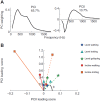Recruitment of faster motor units is associated with greater rates of fascicle strain and rapid changes in muscle force during locomotion
- PMID: 22972893
- PMCID: PMC3597201
- DOI: 10.1242/jeb.072637
Recruitment of faster motor units is associated with greater rates of fascicle strain and rapid changes in muscle force during locomotion
Abstract
Animals modulate the power output needed for different locomotor tasks by changing muscle forces and fascicle strain rates. To generate the necessary forces, appropriate motor units must be recruited. Faster motor units have faster activation-deactivation rates than slower motor units, and they contract at higher strain rates; therefore, recruitment of faster motor units may be advantageous for tasks that involve rapid movements or high rates of work. This study identified motor unit recruitment patterns in the gastrocnemii muscles of goats and examined whether faster motor units are recruited when locomotor speed is increased. The study also examined whether locomotor tasks that elicit faster (or slower) motor units are associated with increased (or decreased) in vivo tendon forces, force rise and relaxation rates, fascicle strains and/or strain rates. Electromyography (EMG), sonomicrometry and muscle-tendon force data were collected from the lateral and medial gastrocnemius muscles of goats during level walking, trotting and galloping and during inclined walking and trotting. EMG signals were analyzed using wavelet and principal component analyses to quantify changes in the EMG frequency spectra across the different locomotor conditions. Fascicle strain and strain rate were calculated from the sonomicrometric data, and force rise and relaxation rates were determined from the tendon force data. The results of this study showed that faster motor units were recruited as goats increased their locomotor speeds from level walking to galloping. Slow inclined walking elicited EMG intensities similar to those of fast level galloping but different EMG frequency spectra, indicating that recruitment of the different motor unit types depended, in part, on characteristics of the task. For the locomotor tasks and muscles analyzed here, recruitment patterns were generally associated with in vivo fascicle strain rates, EMG intensity and tendon force. Together, these data provide new evidence that changes in motor unit recruitment have an underlying mechanical basis, at least for certain locomotor tasks.
Figures





Similar articles
-
Validation of Hill-type muscle models in relation to neuromuscular recruitment and force-velocity properties: predicting patterns of in vivo muscle force.Integr Comp Biol. 2014 Dec;54(6):1072-83. doi: 10.1093/icb/icu070. Epub 2014 Jun 12. Integr Comp Biol. 2014. PMID: 24928073 Free PMC article. Review.
-
Dynamics of goat distal hind limb muscle-tendon function in response to locomotor grade.J Exp Biol. 2009 Jul;212(Pt 13):2092-104. doi: 10.1242/jeb.028076. J Exp Biol. 2009. PMID: 19525436 Free PMC article.
-
Patterns of strain and activation in the thigh muscles of goats across gaits during level locomotion.J Exp Biol. 2005 Dec;208(Pt 24):4599-611. doi: 10.1242/jeb.01940. J Exp Biol. 2005. PMID: 16326942
-
Muscle fibre recruitment can respond to the mechanics of the muscle contraction.J R Soc Interface. 2006 Aug 22;3(9):533-44. doi: 10.1098/rsif.2006.0113. J R Soc Interface. 2006. PMID: 16849250 Free PMC article.
-
Contributions to the understanding of gait control.Dan Med J. 2014 Apr;61(4):B4823. Dan Med J. 2014. PMID: 24814597 Review.
Cited by
-
Validation of Hill-type muscle models in relation to neuromuscular recruitment and force-velocity properties: predicting patterns of in vivo muscle force.Integr Comp Biol. 2014 Dec;54(6):1072-83. doi: 10.1093/icb/icu070. Epub 2014 Jun 12. Integr Comp Biol. 2014. PMID: 24928073 Free PMC article. Review.
-
Age-related differences in calf muscle recruitment strategies in the time-frequency domain during walking as a function of task demand.J Appl Physiol (1985). 2021 Oct 1;131(4):1348-1360. doi: 10.1152/japplphysiol.00262.2021. Epub 2021 Sep 2. J Appl Physiol (1985). 2021. PMID: 34473576 Free PMC article.
-
Muscle function and electromyography: (almost) 70 years since Doty and Bosma (1956).J Neurophysiol. 2025 Jul 1;134(1):337-346. doi: 10.1152/jn.00176.2025. Epub 2025 Jun 23. J Neurophysiol. 2025. PMID: 40549575 Free PMC article.
-
Does a two-element muscle model offer advantages when estimating ankle plantar flexor forces during human cycling?J Biomech. 2018 Feb 8;68:6-13. doi: 10.1016/j.jbiomech.2017.12.018. Epub 2017 Dec 15. J Biomech. 2018. PMID: 29287843 Free PMC article.
-
Accuracy of gastrocnemius muscles forces in walking and running goats predicted by one-element and two-element Hill-type models.J Biomech. 2013 Sep 3;46(13):2288-95. doi: 10.1016/j.jbiomech.2013.06.001. Epub 2013 Jul 18. J Biomech. 2013. PMID: 23871235 Free PMC article.
References
-
- Biewener A. A. (1998). Muscle-tendon stresses and elastic energy storage during locomotion in the horse. Comp. Biochem. Physiol. 120B, 73-87 - PubMed
-
- Biewener A. A., Baudinette R. (1995). In vivo muscle force and elastic energy storage during steady-speed hopping of tammar wallabies (Macropus eugenii). J. Exp. Biol. 198, 1829-1841 - PubMed
-
- Biewener A. A., Konieczynski D. D., Baudinette R. V. (1998). In vivo muscle force-length behavior during steady-speed hopping in tammar wallabies. J. Exp. Biol. 201, 1681-1694 - PubMed
-
- Citterio G., Agostoni E. (1984). Selective activation of quadriceps muscle fibers according to bicycling rate. J. Appl. Physiol. 57, 371-379 - PubMed
Publication types
MeSH terms
Grants and funding
LinkOut - more resources
Full Text Sources

